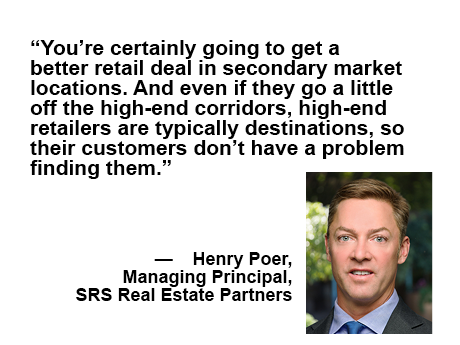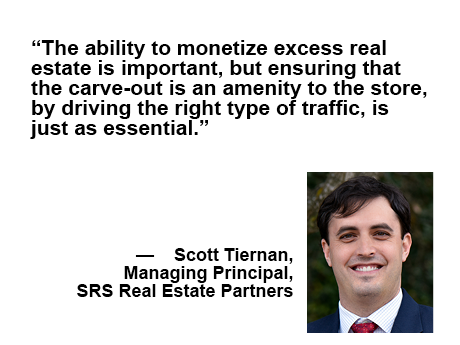High occupancy rates and prohibitive development costs continue to challenge expansion-minded retailers. Only 4.5 percent of total retail space in the United States was available for lease at the end of August, according to CoStar Group. That represents a 35 percent reduction in retail availability over the past decade amid greater absorption and space being removed from the market.
Combined with limited new shopping center development over the past 15 years, the tight conditions are pushing retail real estate experts to get creative when searching for ways to help brands grow, say Henry Poer and Scott Tiernan, managing principals with SRS Real Estate Partners and co-leaders of the brokerage’s Atlanta office.
“Supply and demand for retail space are well out of equilibrium,” says Tiernan, who specializes in landlord and tenant representation. “You’ve got a lot of well-capitalized users looking to grow, and there just aren’t a lot of good locations and spaces available at the moment.”
Secondary Market Appeal
Solutions to the challenges vary among sectors. On the luxury and high street side, brands are having a difficult time finding suitable, affordable options in Chicago, New York, Los Angeles and other major metros, points out Poer, who specializes in representing retailers entering or expanding in multiple markets. That has made cities like Nashville, Jacksonville, Fla., Raleigh, N.C., and Charleston and Greenville, S.C. more appealing. The “Sunbelt Tour” for retailers is very much a real trend, he adds.
“Often, high-end retailers are entering these markets for the first time instead of opening a second or third location in Los Angeles or New York,” Poer explains. “They’re going to be very selective, but shopping districts like King Street in Charleston or in and around Main Street in Greenville are the beneficiaries.”

While luxury retailers traditionally have not made secondary markets high priorities, many markets in the Sunbelt have increasingly attractive demographics amid robust population growth, he notes. Additionally, brands that are paying as much as $600 per square foot on Madison Avenue on Manhattan’s Upper East Side are going to pay exponentially less per square foot in many of the smaller markets. In Greenville, S.C. , the rental rate could be as low as $55 per square foot, he says.
“You’re certainly going to get a better retail deal in secondary market locations,” Poer says. “And even if they go a little off the high-end corridors, high-end retailers are typically destinations, so their customers don’t have a problem finding them. In the past, a retailer entering the Atlanta market might have been fixated on landing in Buckhead. Today, Poncey-Highland, Westside and Avalon are all considered highly sought-after areas for a retailer’s first location in Atlanta.”
Dialing Up Dollars
In the box retail sector, investors who want to build big box space continue to contend with high construction costs and interest rates, even with some leveling off of the former and the Federal Reserve’s recent cut of the latter. But some developers are having luck securing tax incentives to help defray the costs, especially from tertiary cities that are looking to expand their sales tax base, Tiernan says.
“There’s just not a lot of big box development going on anywhere across the country because it’s very hard to underwrite,” he adds. “The only way to get them out of the ground in secondary and tertiary markets is to bring in incentives, particularly in cities where rental rates and exit cap rates are going to be limited.”
The drive to find creative financial solutions isn’t exclusive to developers. In places where large retailers own their stores, some brands are carving out pad sites in parking lots or other areas of excess space to sell or lease to other users, Tiernan says. Frequently, municipalities required the retailers to provide parking ratios that ultimately proved to be too high for modern shopping habits.
Tiernan has been engaged with Lowe’s Home Improvement since 2021 on a national carve-out program and is seeing more retail and institutional landlords look to create carve-out programs. The parcels are typically less than an acre in size and cater to users such as car washes, oil change operators, fast casual restaurants, and small coffee concepts like 7 Brew and Dutch Bros.
“The ability to monetize excess real estate is important, but ensuring that the carve-out is an amenity to the store, by driving the right type of traffic, is just as essential,” Tiernan notes. “If you think about a contractor who is going to Lowe’s — he wants his coffee in the morning or lunch in the afternoon, and it’s right there. It’s a win-win.”
— By Joe Gose. This article was written in conjunction with SRS Real Estate Partners, a content partner of Shopping Center Business.


